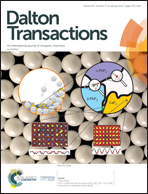Ionic conductivity and structure of M1−xPbxF2 (M = Ca, Sr, Ba) solid solutions prepared by ball milling†
Abstract
Nanocrystalline M1−xPbxF2 (M = Ca, Sr, Ba) solid solutions were prepared by ball milling mixtures of binary parent materials. The structure of the obtained materials was investigated by 19F MAS NMR spectroscopy and XRPD, and their ionic conductivity by impedance spectroscopy. It was found that fluorite-structured solid solutions over the whole range of compositions can be prepared by ball milling for all three systems, closing the broad miscibility gap of the CaF2–PbF2 system. The fluoride ion conductivity increased with increasing Pb content of the solid solutions, with Ba0.10Pb0.90F2 showing the highest conductivity of all samples prepared, being 1.5 orders of magnitude smaller than the one of PbSnF4. Ca1−xPbxF2 showed a fluoride ion conductivity increase which can be assigned to geometric frustration induced disorder. Ball milling of pure PbF2 revealed an increase of the fluoride ion conductivity by 2.5 orders of magnitude in the case of PbF2 containing a large amount of β-PbF2 compared to microcrystalline β-PbF2. Its fluoride ion conductivity is also 2.5 orders of magnitude larger than the fluoride ion conductivity of ball milled PbF2 consisting of a small amount of β-PbF2 but a large amount of α-PbF2 pointing to differently conducting and structured grain boundaries of α-PbF2 and β-PbF2.



 Please wait while we load your content...
Please wait while we load your content...